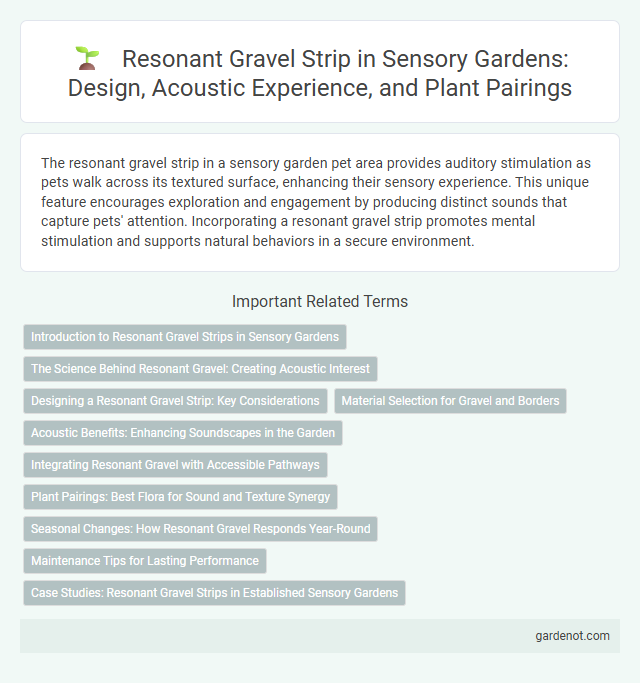The resonant gravel strip in a sensory garden pet area provides auditory stimulation as pets walk across its textured surface, enhancing their sensory experience. This unique feature encourages exploration and engagement by producing distinct sounds that capture pets' attention. Incorporating a resonant gravel strip promotes mental stimulation and supports natural behaviors in a secure environment.
Introduction to Resonant Gravel Strips in Sensory Gardens
Resonant gravel strips in sensory gardens enhance tactile and auditory experiences by producing distinctive sounds underfoot, engaging visitors in multi-sensory exploration. These strips are designed using specific gravel types and layering techniques to optimize resonance and texture, promoting sensory integration and environmental awareness. Incorporating resonant gravel strips supports therapeutic and educational purposes by stimulating sensory processing and encouraging mindful interaction with natural elements.
The Science Behind Resonant Gravel: Creating Acoustic Interest
Resonant gravel strips leverage specific stone sizes and densities to amplify sound vibrations, creating intriguing acoustic effects that engage the auditory senses. The irregular surfaces and varying gravel compositions generate distinct resonance frequencies, enhancing sound propagation and spatial awareness within the sensory garden. This scientifically designed element transforms ordinary pathways into interactive soundscapes, promoting tactile and auditory exploration.
Designing a Resonant Gravel Strip: Key Considerations
Designing a resonant gravel strip in a sensory garden requires selecting specific gravel types known for producing distinct auditory feedback, such as pea gravel or crushed granite. The strip's width and depth must be calibrated to balance footfall impact with sound resonance, typically around 30-50 centimeters wide and 5-10 centimeters deep. Positioning the gravel strip along frequently traveled paths enhances sensory engagement, encouraging visitors to experience tactile and auditory stimulation simultaneously.
Material Selection for Gravel and Borders
Resonant gravel strips utilize carefully selected gravel materials such as smooth pea gravel or crushed limestone to enhance tactile and auditory sensory experiences. Border materials like untreated timber or natural stone provide durable edges that blend seamlessly with the garden's organic aesthetics while containing the gravel effectively. Choosing materials with specific textures and acoustic properties ensures the strip maximizes engagement for visitors with diverse sensory needs.
Acoustic Benefits: Enhancing Soundscapes in the Garden
A resonant gravel strip in a sensory garden significantly amplifies acoustic benefits by producing distinct crunching sounds underfoot, enriching the auditory experience. This natural soundscape enhancement encourages mindfulness and sensory engagement, fostering a calming environment. Its textured surface also aids in sound diffusion, reducing unwanted echoes and promoting a balanced acoustic atmosphere.
Integrating Resonant Gravel with Accessible Pathways
Resonant gravel strips enhance sensory gardens by providing auditory feedback that guides visitors through accessible pathways. These textured gravel sections, designed for tactile and sound stimulation, improve navigation for individuals with visual impairments while adding an interactive element for all users. Integrating resonant gravel within smooth, wheelchair-friendly paths ensures inclusivity and enriches the overall sensory experience.
Plant Pairings: Best Flora for Sound and Texture Synergy
Resonant gravel strips create unique auditory experiences by enhancing the natural sounds produced when footsteps interact with the surface. Ideal plant pairings include low-growing grasses like Blue Fescue and Aromatic herbs such as Lavender, which complement the gravel's texture and amplify sensory engagement. Combining these flora with the gravel strip yields a harmonious blend of sound and tactile sensations, enriching the sensory garden environment.
Seasonal Changes: How Resonant Gravel Responds Year-Round
The resonant gravel strip in a sensory garden transforms with seasonal shifts, producing distinct acoustic patterns as moisture levels and temperature fluctuate. In spring and fall, increased rainfall enhances the gravel's resonance, creating richer, more vibrant sounds underfoot. During winter, frost hardens the gravel, resulting in sharper, crisper tones, while dry summer conditions soften the acoustic effect for a subtler sensory experience.
Maintenance Tips for Lasting Performance
Regularly removing debris and weeds from the resonant gravel strip ensures consistent sound quality and prolongs its durability. Periodic raking helps maintain an even surface, preventing compaction that can diminish resonance. Applying a layer of fresh gravel annually preserves the strip's acoustic properties and overall aesthetic appeal.
Case Studies: Resonant Gravel Strips in Established Sensory Gardens
Resonant gravel strips in established sensory gardens enhance tactile and auditory experiences by producing distinct sounds when walked upon, enriching sensory engagement for visitors. Case studies demonstrate improved accessibility and sensory stimulation, particularly benefiting individuals with visual impairments and sensory processing disorders. Implementation of resonant gravel strips has shown increased visitor interaction and therapeutic outcomes in community and therapeutic garden settings.
Resonant gravel strip Infographic

 gardenot.com
gardenot.com